- Author: Kathy Keatley Garvey
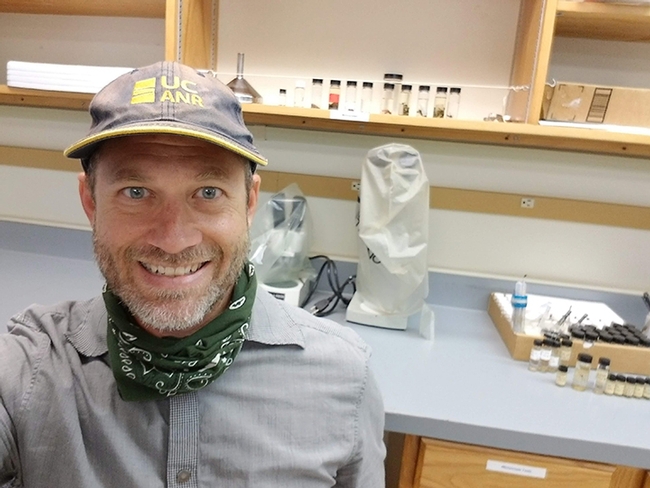
Sutherland, UC Riverside professor and urban entomologist Chow-Yang Lee, and USDA forest entomologist Lori Nelson want to compare the spring swarming populations of Reticulitermes hesperus with the fall swarming populations.
“A major taxonomic question surrounding western subterranean termites remains unsolved,” said Sutherland, the Urban IPM Advisor for the San Francisco Bay Area. “Most termite species simultaneously swarm over a relatively short period during one season, facilitating genetic exchange during mating. Individuals thought to represent Reticulitermes hesperus, however, have been observed swarming during both autumn (usually on a sunny day after the first autumn rain event) and spring (sunny days when soil is moist) suggesting that there are at least two cryptic species considered within the western subterranean termite complex or that speciation is underway (individuals swarming at different times of the year cannot mate with one another).”
In fact, says Sutherland, USDA Forest Service research by Michael Haverty and Lori Nelson indicates that spring and autumn swarming populations can actually be distinguished by different cuticular hydrocarbons (waxes on exoskeleton).
In the collaborative UC IPM, UC Riverside, and USDA Forest Service research project, “we seek to resolve this question once and for all by comparing DNA microsatellite data and cuticular hydrocarbon data from alates (winged termite swarmers) collected during these different seasons,” Sutherland said.
Residents of California, Oregon, Washington, Idaho, western Nevada, southern British Columbia, and northern Baja California can help by collecting at least 25 individuals of swarming Reticulitermes and freezing them in a hard-walled container, such as a pill bottle, film canister or a food storage plastic container. Contributors will receive a Common Cockroaches of California poster or another special gift. Contributing pest management professionals will receive a free training opportunity with ‘IPM' continuing education units for California's Structural Pest Control Board licenses.
Sutherland's program will fund the shipping of the specimens. He may be reached at amsutherland@ucanr.edu for further information, such as if the termite specimens qualify.
About Termites and Sutherland's Work
Termites, like cockroaches, are members of the order Blattodea and evolved some 120 million years ago. Structural infestations of subterranean termites are usually not visible, but the annual flights of winged termites (alates) are. This research will help pest control providers and residents understand the most likely swarming periods in their specific region, improving monitoring and control for these important structural pests.
Sutherland, who began researching termites in 2014, says the western subterranean termite, “is the most damaging wood destroying insect in northern California and most other parts of the Pacific Northwest, causing billions of dollars of damage to homes and other structures each year. Conventional treatments use soil drenches or injections of liquid termiticides to create protective barriers around wooden structures.”
One of his research projects seeks to evaluate an alternative management tactic for subterranean termites: bait station systems that use insect growth regulator insecticides to eliminate entire termite colonies. “Bait systems represent reduced environmental contamination as compared to liquid treatments, but adoption of their use in California and other Western states has been slow to progress,” he said, adding that he hopes his research will demonstrate the relative efficacy of baits and increase both demand for and provision of bait services.
Sutherland, who holds advanced degrees in entomology and horticulture from UC Davis and the University of Florida—including a doctorate in entomology from UC Davis in 2009-- is a Board-Certified Entomologist (Entomological Society of America certification program). He focuses his research on developing new IPM strategies or adapting and implementing current IPM strategies, in cooperation with other researchers, pest control operators, pest management professionals, public agencies, schools, parks, public housing, and regulatory agencies involved with household, structural, and industrial IPM.
His work includes education about IPM principles, development of IPM programs for clientele, reduction in unnecessary pesticide applications, and mitigation of surface water contamination due to urban pesticide applications.
See more information on termites on the UC Statewide Integrated Pest Management (UC IPM) site, Subterranean and Other Termites.
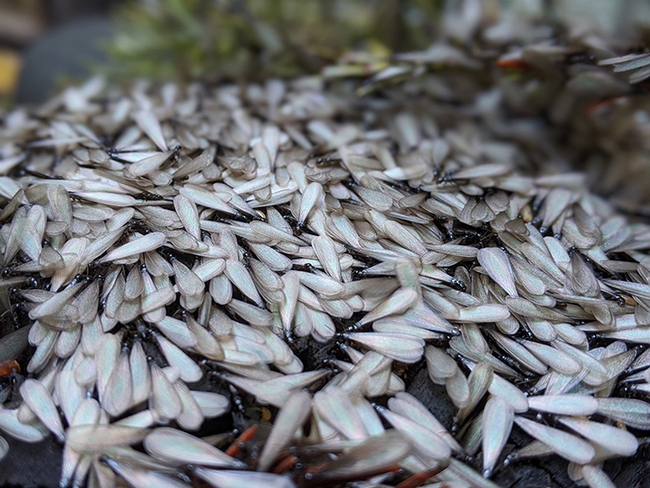
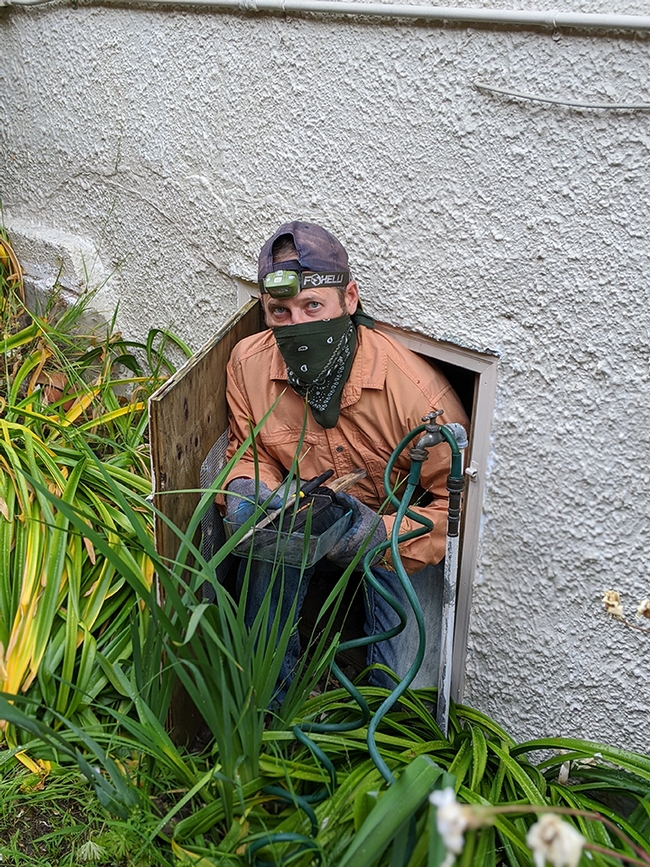
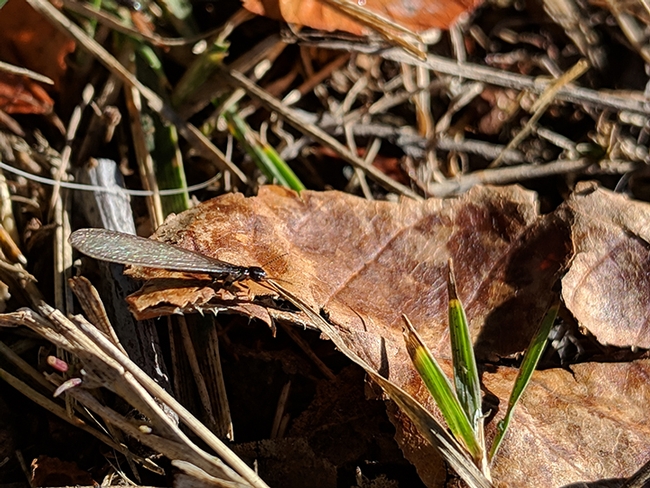
- Author: Kathy Keatley Garvey
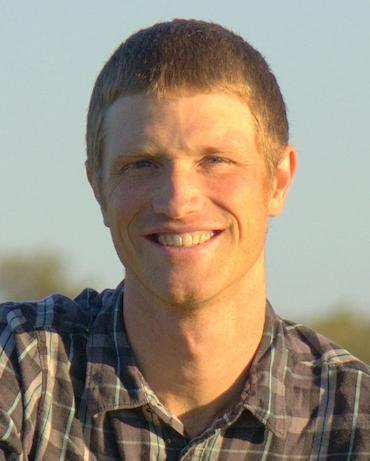
The grants, announced Dec. 13, total $1.1 million.
Grettenberger and his UC Davis research collaborators will receive $499,847 for “A Proactive Approach to Prepare for the Invasion of Tuta absoluta into California.” T. absoluta, a tomato leafminer, is a serious pest throughout Europe, Africa, western Asia and South and Central America and could decimate California's tomato industry, a CDFA spokesman said. “This project will proactively test targeted insecticides, identify native natural enemies that could be used in biological control, and conduct work to assist in breeding plants resistant to this pest. This project will be conducted at UC Davis, throughout California, and in Chile and Peru."
Grettenberger and co-project leaders Alejandro Del Pozo-Valdivia and Daniel Hasegawa of the UC Davis Division of Agriculture and Natural Resources (UC ANR), will receive $261,543 for “Detection, Biology and control of the Exotic Swede Midge (Contarinia nasturtii) for California Cole Crops.” Swede midge, a pest of cole crops in the Northeastern U.S. and Canada, could cause significant management issues for California's large cole crop industry, a CDFA spokesperson said. “This project will collect important information about the biology of Swede midge, test low impact insecticides and botanical products as options for control, assess the possibility of weeds as alternative hosts, and work with growers to start monitoring for the pest. This project will be conducted mainly at UC Davis and in the Salinas Valley.”
The third CDFA grant of $348,893 went to project leaders Mark Hoddle and Jocelyn Millar of UC Riverside for “Proactive Management of Avocado Seed and Stem Feeding Weevils, Heilipus spp. (Coleoptera: Curculionidae: Molytinae).” This project will develop pheromones, identify natural enemies in the host range, and quantify flight capacity of the avocado seed weevils, a CDFA spokesperson said. The weevils, native to Mexico and invasive in Ecuador, feed directly on avocados and could cause substantial damage to the California avocado industry, a CDFA spokesman said. "The California Avocado Commission pledged an additional $150,000 to support this project, a testament to their concern over this pest. The work will be conducted mainly at UC Riverside and in Mexico. “
Each project received strong support from commodities that could be affected by invasive pests. A review committee, of scientists from the U.S. Department of Agriculture, University of California, state government and private pest control advisors, scored the proposals and recommended the recipients.
CDFA is responsible for preventing and mitigating invasive pests in California.
- The Proactive IPM Solutions grants program targets exotic pests likely to arrive in California. It aims to identify and test IPM strategies that can be rapidly implemented if the pests become established in California.
- OPCA, created to provide consultation to the California Department of Pesticide Regulation (DPR), focuses on potential pesticide regulatory impacts and pest management alternatives that may mitigate or prevent such impacts on production agriculture.
Grettenberger, who joined the UC Davis faculty earlier this year, replaces the late Larry Godfrey, who died of cancer April 18, 2017. Grettenberger holds a bachelor of science degree from Western Washington University and a doctorate from Pennsylvania State University. His areas of expertise include field and vegetable crops; insects, mites and other arthropods affecting plants; biological control of pests affecting plants; and beneficial insects.
- Author: Kathy Keatley Garvey
Noted integrated pest management specialist (IPM) Frank Zalom, distinguished professor of entomology, UC Davis Department of Entomology and Nematology, recently received the Perry Adkisson Distinguished Speaker Award from Texas A&M University, College Station, and presented a seminar on “Invasive Species, Integrated Pest Management, and One Perspective from the West Coast.”
Zalom said it was a great honor to receive the award. "Perry Lee Adkisson is among the icons of integrated pest management (IPM)," he said, "and one of the people that I have most looked up to since starting my career in entomology."
Adkisson, chancellor emeritus of the Texas A&M University System and a distinguished professor, now emeritus, at Texas A&M, was the first-ever recipient of all three of the world's major prizes in agriculture: the Alexander von Humboldt Award, the Wolf Prize, and the World Food Prize. He and colleague Ray Smith are credited with developing integrated pest management (IPM).
Both Zalom and Adkisson are past presidents of the Entomological Society of America (ESA) and both are fellows.
Zalom, who holds a doctorate in entomology from UC Davis, joined the UC Davis faculty in 1980 as the Extension IPM coordinator for the UC Statewide Integrated Pest Management Program (UC IPM) and then served as the UC IPM director for 16 years before returning to the Department of Entomology in 2002.
Known nationally and globally for his IPM leadership, Zalom co-chaired the Association of Public and Land Grant Universities' National IPM Committee (NIPMCC) from 1999-2015. He also has served as an IPM representative to the Experiment Station Committee on Organization and Policy (ESCOP) Science and Technology Committee since 2003, USDA Western Region IPM Competitive Grants program manager for 10 years, and on the United States Agency for International Development (USAID) Board of Directors for the IPM CRSP (Collaborative Research Support Programs) from 2001-2005.
Zalom organized and co-chaired--with presidents of four other entomological societies--the first ever International Entomology Leadership Summit, spanning two days within the 2016 International Congress of Entomology (ICE) meeting in September in Orlando, Fla.
Highly honored by his peers, Zalom is an elected fellow of four scientific organizations: ESA, American Association for the Advancement of Science, Royal Entomological Society (London) and the California Academy of Sciences. He is a past president of the Pacific Branch of ESA. He continues to serve as a member of the Entomological Foundation's Board of Directors and the ESA's Science Policy Committee.
Some of his most recent honors: the Entomological Foundation IPM Team Award, the Entomological Foundation Excellence in IPM Award, and the Outstanding Mentor Award from the UC Davis Consortium for Women and Research. He served as the department's vice chair from 2005-08.
Zalom has authored more than 335 peer-reviewed journal articles, book chapters, and books, and has served as major professor for 12 Ph.D. students and seven master's students.
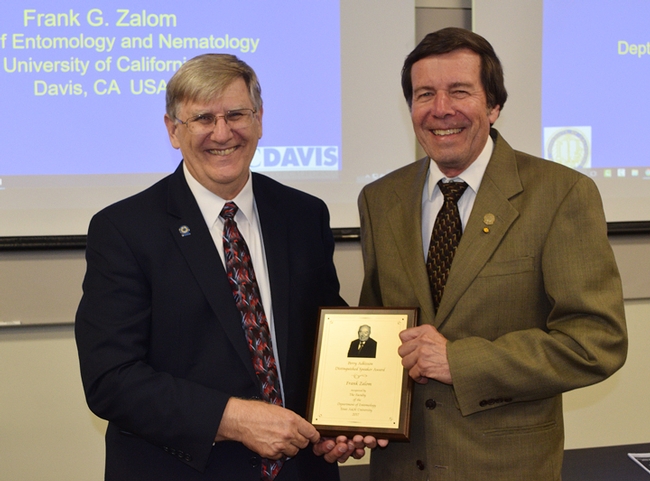
- Author: Kathy Keatley Garvey
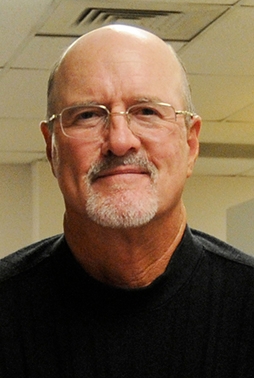
"Dr. Ehler had a remarkable career at UC Davis,” said Steve Nadler, professor and chair of the UC Davis Department of Entomology and Nematology. “In his research he built upon fundamental investigations in integrated pest management (IPM) to provide practical biological control for many different systems. Les was both a national leader in the discipline of biological control, and an outstanding citizen of the department and university.”
Dr. Ehler, who joined the UC Davis Department of Entomology in 1973 and retired in January 2008, was the first biological control specialist on campus and was known as the “quintessential biological control researcher.”
For four decades he championed the use of natural enemies to control agricultural pests and warned of the dangers of pesticides.
Dr. Ehler co-edited the 1990 book, Critical Issues in Biological Control and served four years as president and four years as past president of the International Organization for Biological Control. He also chaired the Entomological Society of America's Biological Control Section.
At UC Davis, Dr. Ehler battled pests such as obscure scale and aphids on oaks, stink bugs on tomato, aphids on sugar beet and white fir, and beet armyworm on alfalfa and sugar beet. His expertise ranges from the theory and practice of biological control to the ecology and management of insects and mites in natural, agricultural and urban environments.
“Les was a meticulous researcher and an excellent applied field ecologist,” said colleague and close friend Extension entomologist Larry Godfrey of the UC Davis Department of Entomology and Entomology. “When he took on a research project, you were confident the project would be conducted well and all aspects of the system considered. He made major contributions to our understanding of stink bug ecology and biological control of stink bugs. Les was also excellent at transferring his knowledge via classroom teaching.”
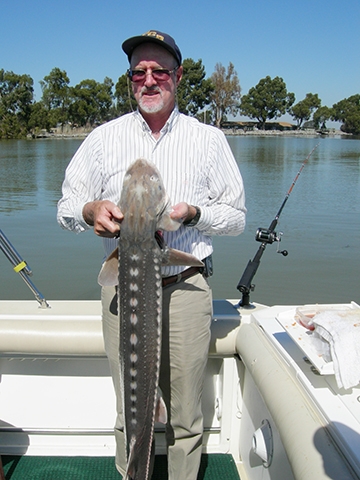
In the late 1990s, Dr. Ehler discovered that pill bugs, also known as roly-poly bugs, prey on the eggs of stink bugs. Up to then, most entomologists classified pill bugs as strictly vegetarians. Stink bugs, major agricultural pests, suck the juices from legume and brassica seeds and fruit of other crops.
In the early 1980s, Dr. Ehler led the Davis team that documented the environmental impact of malathion-bait sprays used to eradicate the Mediterranean fruit fly. The organophosphate was credited with killing the medfly, but also beneficial insects such as honey bees, and natural enemies of various insect pests.
In one study, Dr. Ehler assessed the non-target effects of malathion in the Bay Area. His studies in Woodside, a San Mateo County community on the San Francisco Peninsula, revealed that populations of a native gall midge exploded 90 times the normal level. Ehler compared the gall midge population in Woodside -- where planes sprayed up to 24 malathion applications -- to the untouched Jasper Ridge Biological Preserve near Stanford University. The gall midge is a gnatlike insect pest that lays its eggs in plants; the burrowing larvae form galls.
Dr. Ehler also helped organic farmers solve problems. He designed a stink bug management program for Yolo County organic farmer Robert Ramming of Pacific Star Gardens after learning of the stink bug invasion in his tomato fields.
“The stink bugs were overwintering in his backyard and in the spring, emerging to dine on mustard and then tomatoes,” Dr. Ehler noted in the feature story. “Stink bugs don't seem to prefer tomatoes — they like mustard and wild radish — but when these hosts were plowed under and no longer available, the bugs went for the tomatoes.” Solution: Don't cut the mustard. Plow it under only when the stink bugs aren't a threat to the tomatoes — that is, before they develop wings and disperse.
Quotes from the January 2008 feature story:
- Yolo County organic farmer Robert Ramming of Pacific Star Gardens: “Les determined what stink bugs prefer, their habitat and where they were overwintering. “We planted a five-foot strip of ‘trap' or ‘bribe' crops (mustard and wild radish) around the tomato fields and got rid of 90 percent of the stink bugs.”
- Rachael Long, a UC Cooperative Extension farm advisor in Yolo, Solano, Sacramento counties: “I greatly admire Les for his contributions to IPM that have helped us better understand the biology of some of our major agricultural pests and how to manage them. Les is one of those extraordinary field researchers with a broad knowledge of entomology that make him a great resource for information. In collaborating with Les on various projects I have a much better understanding on how landscapes impact IPM in cropping systems which I believe will help conservation efforts and improve pest control in our agricultural systems.”
- Chemical ecologist Walter Leal, then professor and chair of the UC Davis Department of Entomology: “Les began teaching biocontrol classes for our department in 1974, drawing hundreds of students. He was trained in the 1960s by the founders of integrated pest management (IPM) and he advocated biological control methods as an important IPM pest control strategy. His work led to a better understanding of how predators and parasites can control pests without pesticides.”
- Entomologist Michael Parrella, then associate dean of agricultural sciences in the College of Agricultural and Environmental Sciences: “Les was the first faculty member hired in the Department of Entomology to teach and advance the science and practice of biological control. Trained in classical biological control at UC Berkeley, he was the heart and soul of biological control at UC Davis, and worked in many biological systems from tomatoes to urban landscapes. For many years, Les maintained his own USDA-certified quarantine laboratory which allowed him to work with biological control agents from all over the world. He was a meticulous researcher who maintained a ‘hands-on' approach with all the projects done in his laboratory and he trained many students who are now leaders in the field of biological control around the world.”
Emeritus professor Harry Kaya of the UC Davis Department of Entomology and Nematology said of his close friend and colleague:
"Les and I overlapped as graduate students at UC Berkeley and I have known him for over 45 years. We were reunited as faculty members at UC Davis when I joined the department in 1976. Les was the quintessential entomologist specializing in classical biological control. His research was always thorough and complete and others have commented on his many contributions to the discipline. We co-taught a class on biological control for many years; he covered the theory and application of parasitoids and predators and I did the lectures on pathogens. Les made sure that the students understood the basis for the theoretical aspects of biological control and their application in the field. In the laboratory portion of the class, he took the students into the field to show them biological control agents in action and developed a useful pictorial handout for identifying the common parasitoids and predators found in California. Even in retirement, he assisted farmers in dealing with the stink bug problems in tomatoes."
"Les was the most organized person that I know. Everything in his research lab and office and home had a place and was neatly and logically organized," Kaya noted. "A few years before he retired, he had a plan on what he wanted to do and purchased a fishing boat. The first time we went out, it was clearly a case of the blind leading the blind. We lost more fishing gear without getting a single bite. Les did not see this as a setback, but as a learning experience. He went fishing with professional guides, learned from them, and became an excellent fisherman. He not only took me but many others fishing for striped bass in the Delta, salmon and striped bass in the Sacramento River, and trout, bass, and kokanee at Lake Berryessa."
"I have lost a good friend and colleague. I will miss the many entomological and other stories and his sense of humor we shared on our fishing trips."
Born Jan. 6, 1946 in Lubbock County, Texas and reared on a family farm near the small town of Idalou, Les Ehler received his bachelor's degree in entomology from Texas Tech University, and his doctorate in entomology from UC Berkeley. He joined UC Davis in 1973 as an assistant professor, advancing in 1985 to professor of entomology and entomologist in the UC Davis Experiment Station. Dr. Ehler was an avid fisherman and enjoyed fishing, particularly for sturgeon and salmon.
He is survived by his son Brian of Susanville, Calif., and daughter Mary Ehler Yung and husband, Eric, of Sacramento, and granddaughters Emma Yung and Georgiana Grace Yung. He was preceded in death by his parents, brother Joseph, and sister Loretta. He is survived by brothers Eugene (Mary) of Denton, TX, Howard (Rita) of Midland, TX and sisters Jan Chapman (Carl) of Houston, TX and Amy Willingham of Irving, TX. He is also survived by numerous nieces and nephews.
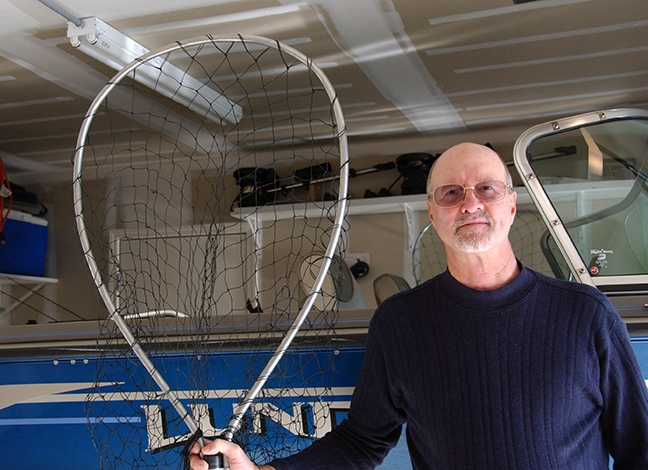
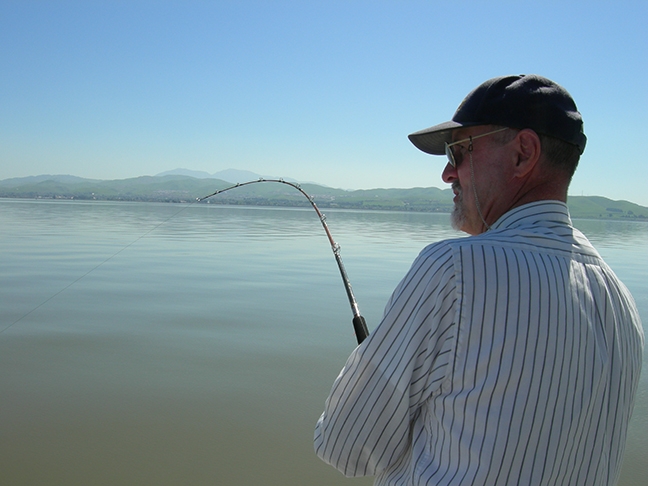
- Author: Kathy Keatley Garvey
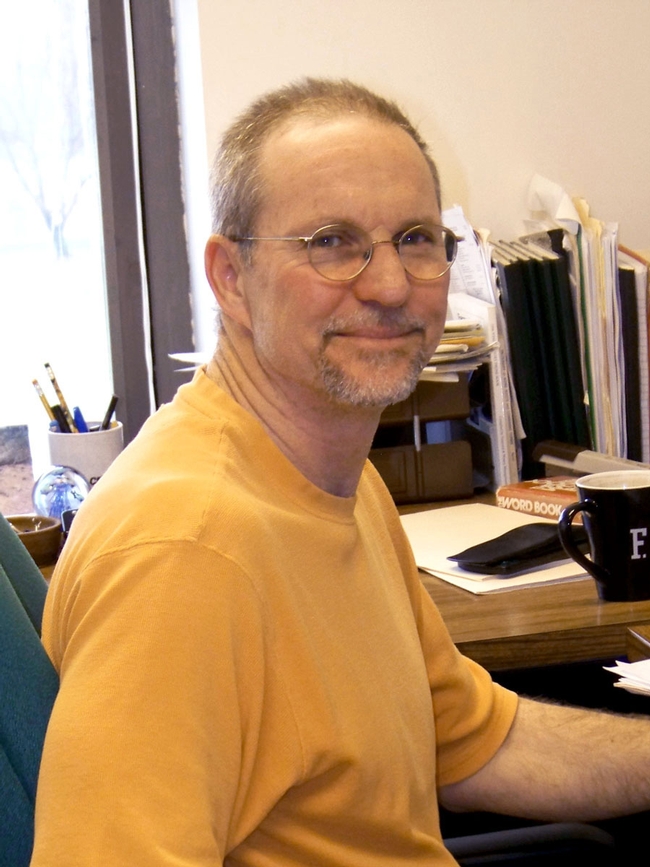
He will receive the award in September at the ESA meeting in Orlando, Fla., being held in conjunction with the International Congress of Entomology (ICE).
Loeb's laboratory is located at the New York State Agricultural Experiment Station in Geneva, N.Y., where he has research and extension responsibilities for grapes and small fruit crops.
Loeb received his doctorate in entomology from UC Davis in 1989, studying with Professor Rick Karban. He earlier (1977) received his bachelor's degree at UC Davis, majoring in vertebrate zoology. "I was really into ornithology as an undergraduate but shifted to insect ecology as I was finishing up my master's (in ecology) at San Diego State," he said.
Excerpts from the ESA award announcement:
"Broadly speaking, his research focuses on species interactions involving plants, herbivores, natural enemies, and, more recently, microbes, with the specific applied goal of developing novel approaches to pest management. Along with collaborators, his research on tritrophic interactions involving leaf morphology (acarodomatia) and predatory and mycophagous mites has established new directions in plant breeding for enhancing conservation biological control.
"He is currently directing considerable research effort toward developing a better understanding of the biology and management of the invasive species spotted wing drosophila (Drosophila suzukii), a significant pest of soft-skinned fruit crops throughout much of North America and abroad. Projects include the chemical ecology and behavior of host finding as a basis for behavioral management, overwintering and spring biology, monitoring and decision making, interactions with microbes, including biological control with entomopathogens, mechanical control using netting, and optimizing chemical control.
"Other research projects ongoing in his lab include vector-pathogen interactions and biological control and pollination ecosystem services. In addition to research and extension responsibilities, he co-teaches a course on grape pest management and serves as program leader for the Department of Entomology and Geneva Experiment Station."
IPM specialist Frank Zalom, distinguished professor of entomology at UC Davis, received the Excellence in IPM award in 2010. His former PhD student, Douglas Walsh, now a professor at Washington State University, won the award in 2013. See list of other recipients.
(Editor's Note: Richard Levine of ESA contributed to this news story.)


